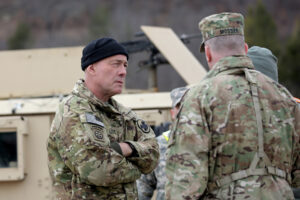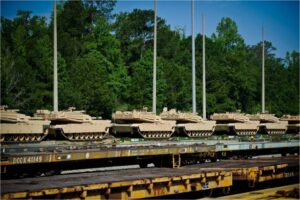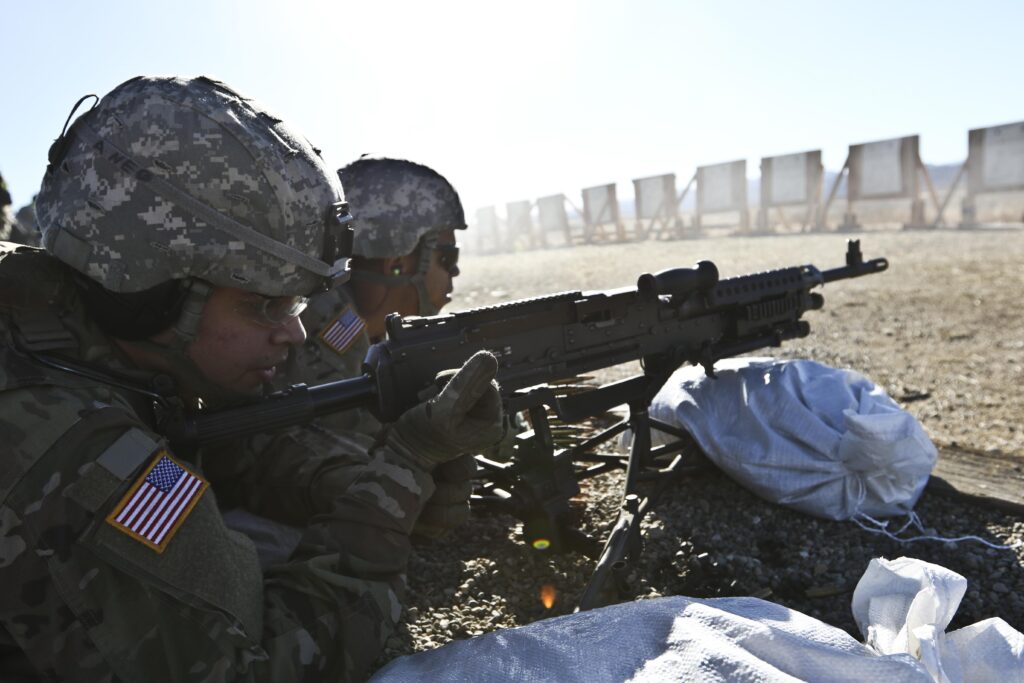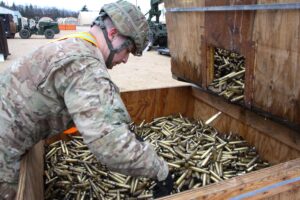Army Reserve Readies For Major War: Cold Steel II
Posted on
WASHINGTON: The Army Reserve is preparing 10,000 soldiers for major war with intensive training on machineguns and automatic grenade launchers. For many, these Cold Steel exercises held across the country are the first time they’ve touched such heavy weapons since basic training, said the chief of the Army Reserve, Lt. Gen. Charles Luckey. The Reserve is also reorganizing to mobilize key units more rapidly in a crisis and to better recruit high-tech talent in cyber warfare and artificial intelligence.

Lt. Gen. Charles Luckey during the Army Reserve’s Cold Steel exercises at Fort McCoy, Wisconsin.
It’s all part of a wider effort to refocus the military from counterinsurgency in Afghanistan and Iraq to what the new National Defense Strategy calls “long-term strategic competitions with China and Russia, (which now) are the principal priorities for the Department.”
The nitty-gritty details of how to better compete fall to officers like Luckey, a career infantryman — and a lawyer in civilian life — who told the Defense Writers’ Group that he’s constantly discovering new niche capabilities the 194,000-strong Army Reserve provides. While the National Guard can mobilize Apache gunship squadrons and full-sized combat brigades, Army Reservists set up fuel pipelines, install water distribution systems, coordinate supply convoys, analyze foreign railroad infrastructure, and conduct other little-noticed and unglamorous logistics without which a modern military cannot function. The Reserve is also expanding its presence in Silicon Valley, Cambridge, Mass., and potentially other high-tech cities like Austin to better recruit cyber experts to run the Army’s massive computer networks.

M1 tanks at Fort Benning, GA.
Even before the US Army deploys abroad, in fact, Army Reserve specialists go to military and commercial ports and terminals across the United States to help move troops out on time with all the right equipment and supplies. Under current war plans, some of those specialists would need to be notified, leave their civilian jobs, and get on site in “less than a week,” Luckey said. They can do it, he added, but it’s a far cry from the post-9/11 era, when deployments were planned so far in advance that most Reserve and Guard units had two or three years to get ready. Large parts of the Reserve now must be ready to “surge” on short notice in a crisis.
Last year, Luckey launched an initiative called Ready Force X to identify key units — the ones that had to get ready rapidly in a crisis — and give them priority for personnel, modernized equipment, training and other resources. RFX has identified about 180 units that would be needed in the first 30 days of an operation because the regular Army simply doesn’t have enough troops in those specialties to keep a major operation going. The RFX analysis also helps Luckey explain to Army planners and leaders what is doable in a deployment and what’s risky.

Army Reserve soldiers train on an M240B machinegun during Cold Steel exercises at Fort Hunter Liggett, Calif.
Performance Under Fire
But deploying smoothly and on time is, literally, just the start of the battle. Once they arrive in the war zone, Reservists will have to do their jobs — often highly technical ones — under constant threat. Afghanistan and Iraq were hard enough, with roadside bombs off base and intermittent rocket and mortar attacks on base, but most troops spent most of their time in mostly secure Forward Operating Bases with showers, electricity, air conditioning and hot food. That won’t be the case against an advanced adversary like Russia, where the Army Chief of Staff, Gen. Mark Milley, has warned static bases will just be big targets for precision weapons, units must relocate constantly to survive, and soldiers will be physically “miserable.”
Even units well away from the “front line” — if such a clear demarcation between friendly and enemy territory even exists — will be targets for “operational fires”: long-range missiles, airstrikes (manned and drone), proxies, saboteurs, commandos, and cyber attack.
“I don’t care if you’re a pipeline person, I don’t care if you’re a medic,” Luckey said. “If you’re going to be subject to the operational fires of the enemy, you’ve got to be able to protect yourself — and, if necessary, kill the enemy in combat.”

An Army Reserve soldier cleans up spent ammunition during Cold Steel training exercises at Fort McCoy, Wis. Almost five million rounds were fired.
Getting that martial message across is a major aim of the Cold Steel exercises. The first Cold Steel trained about 1,900 Reserve soldiers who fired almost five million rounds on the M2 heavy machinegun, M240 medium machinegun, and M19 automatic grenade launcher, firing from both the ground and from vehicles. It was held at Fort McCoy, Wisc. last March and April. Luckey admits he was initially skeptical about sending troops to Wisconsin in winter: “I was the one going really? We’re going to do this in March?” In the end, though, he said, the cold weather made for better, tougher training, and troops came out of the exercises with high morale.
Operation Cold Steel II is a whole series of exercises that began at Fort Hunter Liggett in California last October. Subsequent exercises will occur at Fort McCoy, Wisc. again from February through May; Fort Knox, Ky. in March and April; and New Hersey’s Joint Base McGuire-Dix-Lakehurst in July and August. All told, the plan for Cold Steel II is to train and qualify over 8,000 soldiers on heavy weapons. That brings the total for Cold Steel I and II to about 10,000.
The raw numbers of troops formally qualified on heavy weapons is not the only benefit, Luckey emphasized. The live-fire exercises are also a valuable opportunity for Army Reserve sergeants — the noncommissioned backbone of the force — to take charge of training again, after years of centralized, top-down preparation for Afghanistan and Iraq. Perhaps most important of all, Cold Steel puts the Army Reserve on notice that it’s a new world and a new kind of war.
“Cultural change” is crucial, Luckey said. “If you’re a pipeline person who’s getting shot at, you’re still a soldier.”
Subscribe to our newsletter
Promotions, new products and sales. Directly to your inbox.
